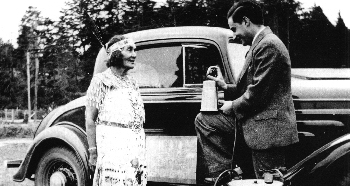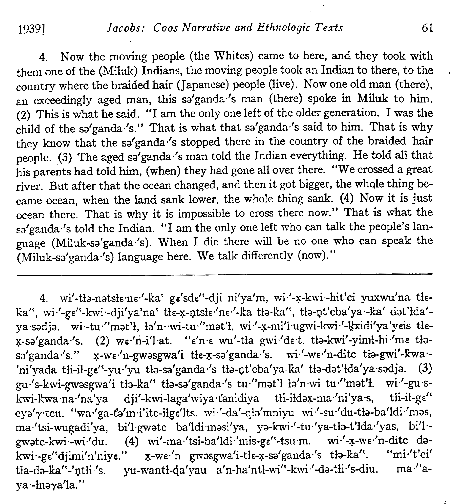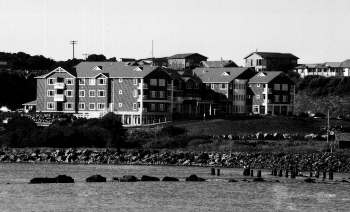OLA Quarterly
Volume 1, Number 2 — Summer 1995Remembering the Rhinoceros:
The Coquille Indian Tribe establishes a unique tribal research library on the southern Oregon Coast
by Don Macnaughtan, Lane Community College
Once, a long time ago, a rhinoceros appeared on a beach in Oregon.
One of the most fascinating myths of the Coquille people relates the story of a fierce one-horned beast with a thick hide, which appeared one day and rampaged amongst the canoes and houses of the people, smashing everything. Spears and arrows were useless against the giant, until it was finally lured into a pit, defeated and killed. Is this a memory of a time when the Ice Age ancestors of the Coquille hunted mastodons and woolly rhinoceros in a primeval North America? Nobody knows for sure, but the Coquille have been in Oregon for a very long time indeed.
 Right: In 1934 renowned anthropologist Melville Jacobs recorded the stories of Annie Miner Peterson, a fluent Miluk speaker, on his mobile wax-disc recording studio. Right: In 1934 renowned anthropologist Melville Jacobs recorded the stories of Annie Miner Peterson, a fluent Miluk speaker, on his mobile wax-disc recording studio.
Between 12,000 and 30,000 years ago, the Siberian ancestors of the Coquille crossed the Bering land bridge and began the first discovery of the New World. About 10,000 years ago, they appeared along the Oregon coast, following the receding ice into the rich valleys and bays of a new home. These people called themselves Miluk, and they settled along the southern margins of Coos Bay and around the mouth of the Coquille River. About 4,000 years ago, a second migration of North Asians paddled across Bering Strait and colonized northern Canada. These people were Athapaskans, known in their language as Dene. Some Athapaskans moved south, mostly to Arizona and New Mexico to become the Navajo and Apache, but one Athapaskan band inexplicably broke away and made a thousand-mile detour to Southern Oregon, where they settled on the upper Coquille River. Descendants of these two groups - the Miluk and the Dene - make up the modern Coquille tribe.
The Coquille lived in an area of amazing wealth and diversity. Wildlife was abundant, and the Miluk and Dene lived well on salmon, deer, elk, camas, shellfish, and sea mammals. Timber was plentiful and easily worked, and the villagers were able to construct substantial plank houses and rugged ocean-going canoes. The cultural landscape was also extraordinarily diverse. In a stretch of coast that today can be driven in an hour, people spoke four completely different languages. The 40 Coquille villages maintained a complex set of relationships with their neighbors to the north and south, through marriage, trade and political alliances. Warfare sometimes disrupted daily life, but the Miluk in particular had a reputation for being peaceful people. Religious and spiritual life was also very rich and complex. The mythological pantheon was filled with a host of earthy, funny, and terrifying characters, the most famous of which was Five-Generation Trickster, sometimes called Coyote or World-Changer, who was the hero of a great myth cycle that was told once a year at mid-winter.
Although their world was relatively isolated, outsiders would sometimes appear in Coos Bay. Alsea and Chinook traders paddled down from the north coast, bargaining with dentalium shell, the money of the Northwest Coast. Occasionally, more sinister fleets of slavers would raid the Coquille villages from as far away as Vancouver Island. Other strange vessels appeared - lost Spanish galleons from the Manila run, and drifting junks from East Asia. On one such junk, a boatload of Miluk apparently joined the trip back to Asia, and a nineteenth century Miluk-speaking sailor on a visit to Japan was startled to hear his language spoken by a very old man, the last survivor of the emigrants.
 Left: One of Mrs. Peterson's stories, in English and Miluk, telling of a Coquille voyage to Japan, the land of the "braided hair people." Left: One of Mrs. Peterson's stories, in English and Miluk, telling of a Coquille voyage to Japan, the land of the "braided hair people."
But none of the intruders had the devastating impact of the final arrivals. First, deadly epidemics ravaged the coast as American and British ships arrived. Between 1851 and 1855, miners looking for gold repeatedly attacked the Coquille village at Bandon, massacring the inhabitants. By the mid-1850s, the American Indian population in Coos and Curry counties had plummeted from 8,000 to a few hundred. In 1856, troops rounded up the survivors and deported them to concentration camps at Yachats and Siletz, where they were virtually abandoned and left to starve, along with most of the other native peoples of Western Oregon. Not only were the people physically exterminated, but a unique culture was lost. An intricate meta-physical, political and social system, built up over millennia, was effectively demolished and discarded. The very landscape of the Coquille was destroyed. Old village sites were plowed under, and canoes and house timbers were converted to horse troughs and fences. Even the Coquille's sacred Grandmother or Tupper Rock at Bandon, a gigantic monolith, was demolished to build the Coquille River jetty.
The survival of the Coquille is from this point almost miraculous. Some Coquille and part-Coquille families remained in the Coos Bay region - the Wassons, the Neds, the Tanners, and others. Through these families, Coquille traditions were kept alive, even though the Federal government declared the tribe extinct in 1954, along with 60 other Western Oregon tribes. However by 1989, the tide had turned, and after a long campaign, federal recognition was again extended to the Coquille.
Federal recognition has opened new doors for the Coquille. The tribe has established an economic development arm, the Coquille Economic Development Corporation, which has initiated a large number of ambitious projects. The most visible is "The Mill," a casino on the North Bend waterfront, which will eventually provide 1,000 jobs. However, CEDCO is also developing forestry, cranberry production, 100 units of tribal housing, a 400-acre business park, and other projects worth millions to the south coast economy. Eventually, the tribe expects to clear about $25 million each year from various investments, all in Coos County. About 30% will be plowed into social, cultural, and educational programs for tribal members, and the remainder reinvested in economic development. By the turn of the century, the Coquille tribe should be one of the biggest business enterprises in southwest Oregon.
 Right: The Dene-Miluk Cultural Center at Heritage Place, Bandon. Right: The Dene-Miluk Cultural Center at Heritage Place, Bandon.
On the Bandon waterfront, the tribe has opened a retirement home called Heritage Place; this will also house the Dene-Miluk Cultural Center, a library and museum dedicated to the culture and history of the Coquille and the 60 other native tribes of Western Oregon. A primary reason for the library is to enhance and develop Coquille cultural identity. Much had been lost over the last 150 years, although quite a lot of traditional information has survived. Many stories and traditions have remained privately in families, but there is also much information locked away in distant libraries and museums, a treasure that has been called a "captured heritage." Between 1880 and 1970, a number of academic researchers had worked with the surviving elders of the Coquille tradition. For example Coquille Thompson, perhaps the last Dene speaker, had worked with three generations of anthropologists, tirelessly passing on the riches of a long traditional life. He lived for over 100 years, and valuable manuscript archives of his work with anthropologists still exist. Many others had also contributed their knowledge, especially Annie Miner Peterson (who spoke English, Miluk, and Hanis Coos), Ida Mecum, and Susan Ned. Like many other contemporary tribes, the Coquille decided that this cultural trove should be repatriated, and that it was time for the "captured heritage" to be identified and brought home. In May 1994, I was asked by the tribe to assist in this process.
The first step was to create a library building. This process is still underway, and the library will occupy the ground floor of Heritage Place in Bandon. The site for Heritage Place was the most sacred place in tribal tradition, known in Miluk as umnatL qwLai or Grandmother Rock, near the site of the old village of nasomah. The site is on a bluff overlooking the mouth of the Coquille River, with a spectacular view beyond to the coastal dunes and the Pacific surf. The library is a new 6,000 sq. ft. facility with room for print, microform and manuscript material, artifacts, computer terminals, display cases, as well as video and audio facilities. The library should be open in late 1995.
My assignment was twofold: to locate and repatriate the documented cultural record of the Coquille and to work with the tribe to outline a set of principles governing the operation of the library. The first part of the task was fairly straight-forward. Up to the present, I have acquired about 400 books, theses and dissertations, manuscripts, government documents, audio and video recordings, articles, microfilm sets, maps, and charts. The material covers everything from folklore and the oral tradition to archaeology, linguistics, and ethnology. Some of the more unusual items include rare tape recordings in the Miluk language, the complete papers of anthropologists John Peabody Harrington and Melville Jacobs, and a nine-foot-long, hand-lettered family chart tracing Coquille lineages back to pre-European times. Other information is being systematically gathered from the major archives of Pacific Northwest anthropology, especially from the Smithsonian Institution (6,000 pages of photocopied manuscripts) and from the University of Washington.
Much of the information will be immediately useful. For example, the tribe is recovering the Miluk language through classes, and archaeological site data is critical for protecting important tribal locations from vandals, artifact hunters, and thoughtless construction projects. The tribe feels strongly that this process is one way of recovering their own past and bringing back to the Dene and Miluk the culture that is rightfully theirs. Additionally, the tribe intends that the collection will become a unique, comprehensive resource for and about all the American Indian tribes of Western Oregon.
The other aspect of this project has been rather more challenging. What sort of library did the tribe want? I was asked to write a policy manual for the library, and this brought up some fundamental questions about the nature of the library. Would this be a library for the Coquille only, or would it be open to all? What would be the status of sacred traditions that had been held within families, sometimes for generations? Some families felt that the voices of their ancestors, including important rituals that had been originally recorded on wax sixty years ago, should not be heard outside certain traditional contexts, if indeed at all. As another example, the myth cycle of Five-Generation Trickster should only be narrated in winter: Is it right that it be replayed on tape at other times of the year? None of these questions has an easy answer, and all will be debated within the tribe for years to come. For the present however, the tribe has taken a direction toward an open library, available to the general public. Anybody may walk through the doors and use the library's facilities for research and exploration, although materials will be non-circulating. There will also be special protocols connected to rare and sensitive resources, such as some recordings and texts. Additionally, some archaeological information is legally embargoed to protect sites from looters.
This approach has opened up the risk of exploitation or abuse of the tribe's cultural materials, but it has also created enormous opportunities for greater understanding and for cooperation and growth through contact with the rest of the community. For example, this approach has permitted the library to plan on adding its holdings to Coastline, the Coos County regional database, accessible throughout the region on an Innovative Interfaces system. The complete library holdings, including many unique records, will also be added to the OCLC database. In creating an open and accessible library, the tribal leadership is looking ahead to the nature of the tribe's relationship with the broader community in the Coos Bay region. This will be especially important as Coquille economic development begins to have a greater local impact. At a time when the tribe is looking at areas where it can create local goodwill, a freely accessible library may be a valuable contribution.
There are also plans to convert to electronic format some of the extensive text and visual information about the Coquille and other Western Oregon tribes. Where copyright restrictions allow, this material could then be pub-lished as World Wide Web documents on the Internet. The academic and research communities will adapt well to this, but only experience will show how well tribal members in general use these innovations. Some studies do indicate that American Indians use Internet resources more intensively than any other ethnic group, and Web sites already exist for the Oneida and a few other tribes. Nevertheless, this will be an untested and revolutionary approach to disseminating cultural materials, and it raises some questions of appropriateness and sensitivity.
How will this library be used in the future? We hope that it will be useful to a variety of communities, including amateur and academic researchers, other American Indian people, local Coos and Curry residents and other interested Oregonians, and especially the members of the Coquille Tribe. Fortunately, the library has a strong built-in constituency: Coquille people are intensely interested in their heritage and traditions, and the library will do much to reflect this pride. Like any library though, the Dene-Miluk Cultural Center will still need to make itself relevant to its users. An important task for the tribal leadership will be to encourage tribal members to understand that they have a stake in the library, and that it is relevant for them as well as for the scholarly community. This will be a significant challenge for the future of this unique Oregon library.
Bibliography
1. Anderson, Troy.
Miluk dictionary.
Stanford: Stanford University, 1990.
2. Frachtenberg, Leo J.
Coos texts.
New York: Columbia University Press, 1913.
3. Frachtenberg, Leo J. and Henry H. St. Clair.
"Traditions of the Coos Indians of Oregon."
Journal of American Folklore 22 (1909): 25-41.
4. Hall, Roberta L.
The Coquille Indians: yesterday, today and tomorrow.
Lake Oswego, OR: Smith, Smith & Smith, 1984.
5. Hall, Roberta L.
"Language and cultural affiliations of natives residing near the mouth of the Coquille River before 1851."
Journal of Anthropological Research 48 (1992): 165-184.
6. Hall, Roberta L.
Oral traditions of the Coquille Indians.
Corvallis: Oregon State University, 1978.
7. Hall, Roberta L. and Don A. Hall.
"The village at the mouth of the Coquille River."
Pacific Northwest Quarterly 82.3 (1991): 101-108.
8. Jacobs, Melville.
Coos myth texts.
Seattle: University of Washington, 1940.
9. Jacobs, Melville.
Coos narrative and ethnologic texts.
Seattle: University of Washington, 1939.
10. Miller, Jay and William R. Seaburg.
"Athapaskans of Southwestern Oregon."
Handbook of North American Indians, vol. 7: Northwest Coast.
Washington: Smithsonian Institution, 1990. 580-588.
11. Peterson, Annie Miner.
"A Coos Indian woman looks at life."
Many faces: an anthology of Oregon autobiography.
Corvallis: Oregon State University, 1993. 152-159.
12. Pierce, Joe E.
"Genetic comparisons of Hanis, Miluk, Alsea, Siuslaw and Takelma."
International Journal of American Linguistics 32 (1966): 379-387.
13. Pierce, Joe E.
"Hanis and Miluk: dialects or unrelated languages?"
International Journal of American Linguistics 31 (1965): 323-325.
14. United States.
Coquille Restoration Act.
Washington: GPO, 1989.
15. Walters, Anthony B.
A reconstructed ethnobotany of the Coquilles, emphasizing microbes and cryptogams.
Corvallis: Oregon State University, 1982.
16. Ward, Beverly H.
"Grandmother Ned: daughter of a Coquille Indian chief."
Oregon Coast Feb.-Mar. 1985: 21-23.
17. Wasson, George B.
"The memory of a people: the Coquilles of the Southwest Coast."
The first Oregonians. Eds. Carolyn M. Buan and Richard Lewis.
Portland: Oregon Council for the Humanities, 1991. 83-88.
18. Zenk, Henry B.
"Siuslawans and Coosans."
Handbook of North American Indians, vol. 7: Northwest Coast.
Washington: Smithsonian Institution, 1990. 572-579.
Back to Table of Contents |
